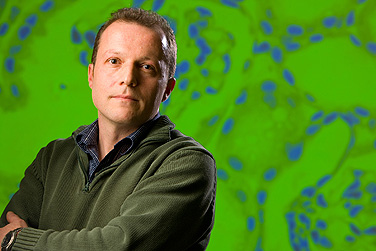News
Enzyme degrades protein linked to cancer
 An enzyme identified by UB biologist Stefan Roberts may lead to a better understanding of how childhood and adult cancers differ. Photo: DOUGLAS LEVERE
An enzyme identified by UB biologist Stefan Roberts may lead to a better understanding of how childhood and adult cancers differ. Photo: DOUGLAS LEVERE
UB biologists have identified an enzyme that degrades an important protein present in cancers of both adults and children.
The findings, published in the current issue of Molecular Cell, could lead to more effective therapies for cancers in which the protein—Wilms’ tumor 1 (WT1)—is involved, as well as to a better understanding of how childhood and adult cancers differ.
“This is the first study to show that treatment of cultured cancer cells with chemotherapeutic drugs can cause destruction of the Wilms’ tumor 1 by an enzyme called HtrA2/Omi,” says Stefan Roberts, assistant professor of biological sciences, College of Arts and Sciences, and lead author on the paper. The research was conducted at the University of Manchester (England) and at UB.
“We found that when cells are treated with etoposide, a common chemotherapeutic agent, HtrA2 breaks down Wilms’ tumor 1 into tiny pieces,” explains Roberts. “The chemotherapy agent is somehow switching on the HtrA2 enzyme, which then destroys Wilms’ tumor 1.”
This is good news for many adult cancers, such as those of the breast, lung and some leukemias, where Wilms’ tumor 1 acts as an oncogene, promoting cancerous growth.
“By eliminating WT1, we found that the cells in these lines became more sensitive to the chemotherapeutic drugs and died more quickly,” Roberts says. “So since having WT1 in tumor cells is associated with poor outcomes, then eliminating it makes the cancer more sensitive to drugs, possibly requiring less drug and resulting in fewer side effects.”
These attributes are making HtrA2 a potential good candidate for drug design. But it turns out that WT1 is not always a bad thing for tumors: in certain childhood cancers, it works not as an oncogene, Roberts explains, but as a tumor suppressor.
“Since this is the case with Wilms’ tumor, a childhood cancer of the kidney, this finding creates the necessity for identifying and using drugs in these cancers that won’t eliminate WT1,” he explains.
Roberts’ lab, which specializes in gene regulation—a strength of the UB Department of Biological Sciences—is now looking at what changes the function of WT1, making it a tumor suppressor in some cases and an oncogene in others.

Reader Comments
Kathleen P Pascall-Falletta says:
I am so proud to be a part of the UB family and to be enrolled in Lectures such as Cell Bio. It truly is the cutting edge of research here at UB and we as a student body are lucky enough to be taught by the most experienced and well educated Researchers and Professors. They bring exciting new developments right into the class room. I look forward to all UB has to offer me and the community as well.
Posted by Kathleen P Pascall-Falletta, undergraduate student, 02/03/10